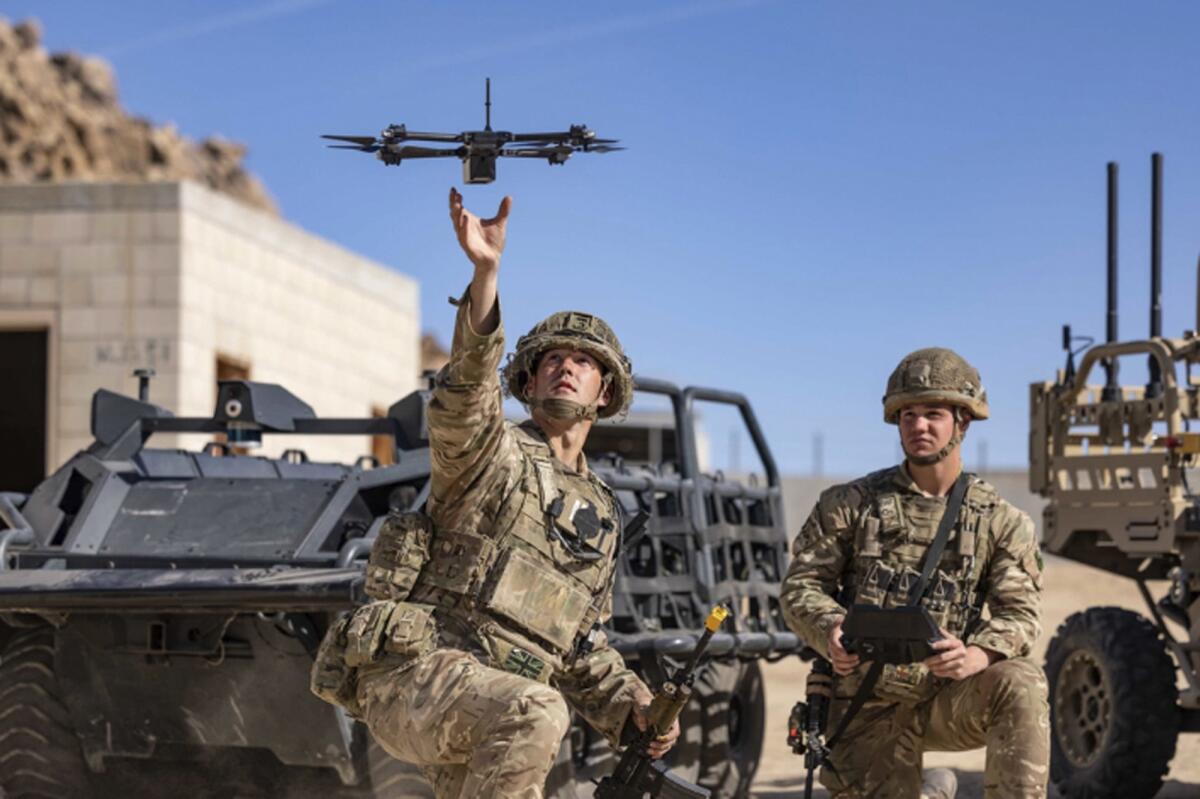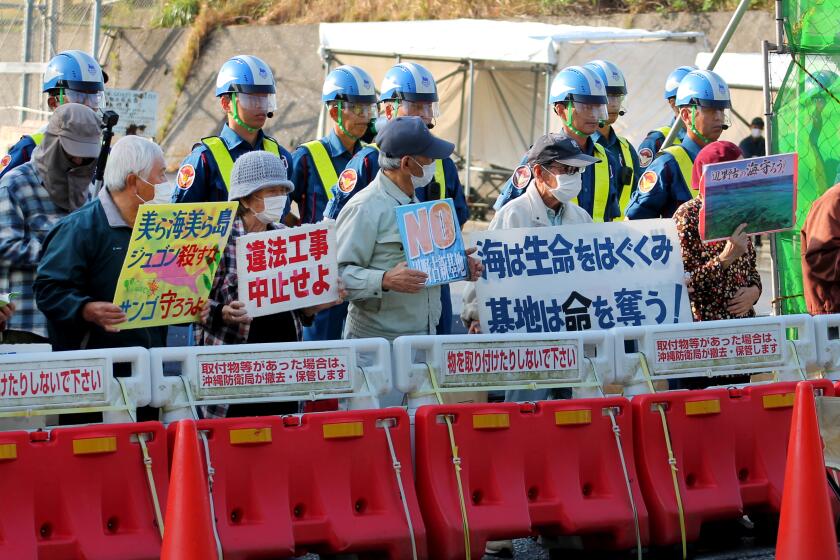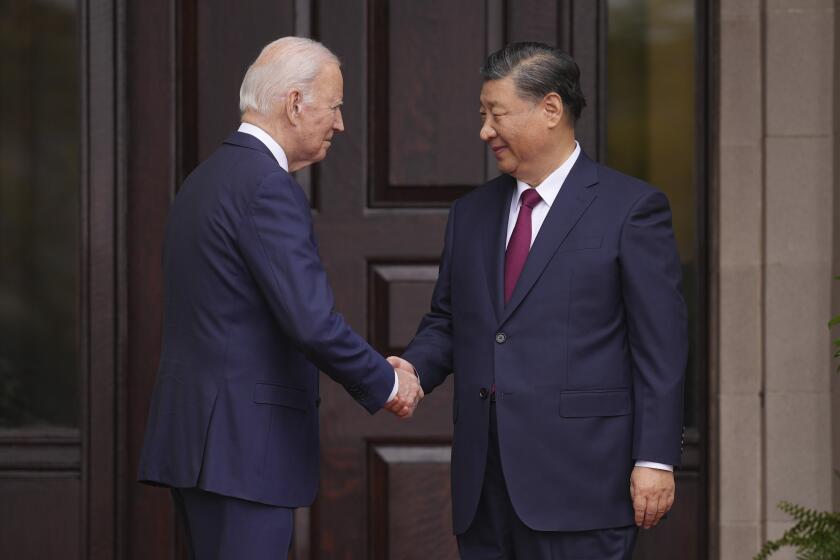U.S.-China competition to build drone swarms could fuel global arms race, analysts say

- Share via
As their rivalry intensifies, U.S. and Chinese military planners are gearing up for a new kind of warfare in which squadrons of air and sea drones equipped with artificial intelligence work together like swarms of bees to overwhelm an enemy.
The planners envision a scenario in which hundreds, even thousands of the machines engage in coordinated battle. A single controller might oversee dozens of drones. Some would scout, others attack. Some would be able to pivot to new objectives in the middle of a mission based on prior programming rather than a direct order.
The world’s only AI superpowers are engaged in an arms race for swarming drones that is reminiscent of the Cold War, except drone technology will be far more difficult to contain than nuclear weapons. Because software drives the drones’ swarming abilities, it could be relatively easy and cheap for rogue nations and militants to acquire their own fleets of killer robots.
The Pentagon is pushing urgent development of inexpensive, expendable drones as a deterrent against China acting on its territorial claim on Taiwan. Washington says it has no choice but to keep pace with Beijing. Chinese officials say AI-enabled weapons are inevitable, so they, too, must have them.
The unchecked spread of swarm technology “could lead to more instability and conflict around the world,” said Margarita Konaev, an analyst with Georgetown University’s Center for Security and Emerging Technology.
Growing concerns over war with China have Japan’s southwestern islands scrambling to bolster defenses.
As the undisputed leaders in the field, Washington and Beijing are best equipped to set an example by putting limits on military uses of drone swarms. But their intense competition, China’s military aggression in the South China Sea and persistent tensions over Taiwan make the prospect of cooperation look dim.
The idea is not new. The United Nations has tried for more than a decade to advance drone nonproliferation efforts that could include limits such as forbidding the targeting of civilians or banning the use of swarms for ethnic cleansing.
Drones have been a priority for both powers for years, and each side has kept its advances secret, so it’s unclear which country might have an edge.
It’s not clear how many drones a single person would control. A spokesman for the Defense secretary declined to say, but a recently published Pentagon-backed study offers a clue: A single operator supervised a swarm of more than 100 cheap air and land drones in late 2021 in an urban warfare exercise at an Army training site at Ft, Campbell, Tenn.
Not to be outdone, China’s military claimed last year that dozens of aerial drones “self-healed” after jamming cut their communications. An official documentary said they regrouped, switched to self-guidance and completed a search-and-destroy mission unaided, detonating explosive-laden drones on a target.
Incoming Taiwanese President Lai Ching-te must grapple with an increasingly fraught relationship with China that has edged closer to armed conflict.
A year ago, CIA Director William Burns said Chinese Communist Party leader Xi Jinping had instructed his military to “be ready by 2027” to invade Taiwan. But that doesn’t mean an invasion is likely.
Just before he died last year, former U.S. Secretary of State Henry Kissinger urged Beijing and Washington to work together to discourage AI arms proliferation. They have “a narrow window of opportunity,” he said.
Xi and President Biden made a verbal agreement in November to set up working groups on AI safety, but that effort has so far taken a backseat to the arms race for autonomous drones.
The competition is not apt to build trust or reduce the risk of conflict, said William Hartung, a senior research fellow at the Quincy Institute for Responsible Statecraft.
If the U.S. is “going full speed ahead, it’s most likely China will accelerate whatever it’s doing,” Hartung said.
Biden sought to smooth over tensions with China’s Xi, who said conflict with the U.S. has ‘unbearable consequences’ for both countries.
There’s a risk China could offer swarm technology to U.S. foes or repressive countries, analysts say. Or it could be stolen. Other countries developing the tech, such as Russia, Israel, Iran and Turkey, could also spread the know-how.
U.S. national security advisor Jake Sullivan said in January that U.S.-China talks set to begin sometime this spring will address AI safety. Neither the Defense secretary’s office nor the National Security Council would comment on whether the military use of drone swarms might be on the agenda.
The Chinese Foreign Ministry did not respond to a request for comment.
Military analysts, drone makers and AI researchers don’t expect fully capable, combat-ready swarms to be fielded for five years or so, though big breakthroughs could happen sooner.
“The Chinese have an edge in hardware right now. I think we have an edge in software,” said Chief Executive Adam Bry of U.S. drone maker Skydio, which supplies the Army, the Drug Enforcement Agency and the State Department, among other agencies.
Chinese military analyst Song Zhongping said the U.S. has “stronger basic scientific and technological capabilities” but added that the American advantage is not “impossible to surpass.”
Paul Scharre, an AI expert at the Center for a New American Security think tank, believes the rivals are at rough parity.
“The bigger question for each country is about how do you use a drone swarm effectively?” he said.
That’s one reason attention is fixed on the war in Ukraine, where drones work as eyes in the sky to make undetected frontline maneuvers all but impossible. They also dispatch death from the sky and serve as sea-skimming ship killers.
Drones in Ukraine are often lost to jamming. Electronic interference is just one of multiple challenges for drone swarm development.
Researchers are also focused on the difficult logistics of marshaling hundreds of air and sea drones over vast expanses of the western Pacific for a potential war over Taiwan.
Julie Adams, an Oregon State University robotics professor, has collaborated with the U.S. military on drone-swarm research including the 2021 exercise at Ft. Campbell.
She said she was particularly impressed with a swarm commander in an exercise last year at Fort Moore, Ga., who single-handedly managed a 45-drone swarm over 2½ hours with just 20 minutes of training.
“It was a pleasant surprise,” she said.
Was he a video game player, she was asked.
Yes, she said. “And he had a VR headset at home.”
Bajak writes for the Associated Press. AP writer Zen Soo in Hong Kong contributed to this report.
More to Read
Sign up for Essential California
The most important California stories and recommendations in your inbox every morning.
You may occasionally receive promotional content from the Los Angeles Times.













